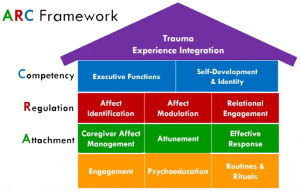How Mercy Home Makes Mental Health A Priority
Mercy Home for Boys & Girls offers a variety of mental health resources to support the wellbeing of our young...
April 22, 2025
September 19, 2017
More than 67% of American children have experienced a traumatic incident by age 16.
That means nearly 7 out of 10 children have been exposed to sexual abuse, domestic abuse, or neglect by their junior year of high school.
Some traumatic incidents last months, or years, long enough for a child’s entire view of the world and themselves to change. Even brief events can cause children to spend years worrying they could happen again. Trauma not only leads to children’s unhappiness, but to social problems including higher rates of crime and incarceration, heroin addiction, and unemployment for victims of trauma.
As Emily Neal, Mercy Home’s clinical director, has said: “Trauma is a public health crisis.”
We have written a lot on the nature of trauma and how it affects children. Sometimes trauma is a one-time event, but more often it is a complex, long-term event that completely changes a child’s view of herself and her world. Sexual abuse, neglect, rape, and domestic violence are among the most common traumatic events that children face.
Trauma causes serious long-term problems both for the survivor and society.
On an individual level, the despair of trauma can lead to depression, trouble paying attention, anxiety, and behavioral problems in school. If left unchecked, these reactions can continue long enough to thwart a survivor’s education and social abilities, which can lead to everything from trouble making friends into adulthood to lifelong poverty and increased likelihood of incarceration or drug abuse.
On a social level, these higher rates of poverty, incarceration, and drug abuse carry a high cost to society. The social services required to maintain prisons, issue food stamps and unemployment, and hospitalize addicts are expensive. If it’s possible to stop trauma or alleviate it early on, the costs of these services to society could be lowered.
It’s more complicated than that.
The main problem this bill address is that, while we have plenty of what it calls “evidence-based trauma-informed treatment” for survivors (we’ll get to that term in a minute), that therapy is rarely being implemented.
The solutions aren’t always as easy as they might sound. Many of the makeshift solutions we had in the past for misbehaving kids have turned out only to punish behavior, not to correct it.
For instance, imagine a child who is neglected at home and so he acts out in school for attention despite a teacher’s repeated warnings to stop. The overworked teacher, needing to gain control of the classroom, suspends the child. Unfortunately, while this removes the child’s distraction from a classroom, misbehaving children are often unclear on why they have been suspended. Then, as soon as they’re back in the classroom, they misbehave again.
In fact, we have therapy solutions that can not only stop behaviors that originated in trauma, but can help children understand why they should make a better decision next time.
Unfortunately, information about these kinds of therapy are not widely available from trusted sources, and trusted sources who do have evidence that these therapies work don’t have a convenient channel to release them nationwide to stop the “public health crisis of trauma.”
One of the most important functions of this bill is to create that channel by linking social service agencies, schools, and federal agencies to understand the nature of trauma and how to intervene in the lives of its survivors not only for their benefit but to effect change in the nationwide attitude toward resolving trauma. Trauma causes serious long-term problems both for the survivor and society.
On an individual level, the despair of trauma can lead to depression, trouble paying attention, anxiety, and behavioral problems in school. If left unchecked, these reactions can continue long enough to thwart a survivor’s education and social abilities, which can lead to everything from trouble making friends into adulthood to lifelong poverty and increased likelihood of incarceration or drug abuse.
On a social level, these higher rates of poverty, incarceration, and drug abuse carry a high cost to society. The social services required to maintain prisons, issue food stamps and unemployment, and hospitalize addicts are expensive. If it’s possible to stop trauma or alleviate it early on, the costs of these services to society could be lowered.
It’s a long term that essentially means: We’ve gotten ourselves into this public health crisis because we haven’t been identifying and treating trauma in ways where we can measure their effectiveness. Perhaps we can’t measure them, or when we have measured them they have turned out to be ineffective. So let’s respond to trauma and its effects with treatments we know work.
One of these approaches that we use at Mercy Home is the ARC Framework. ARC stands for (A)ttachment, (R)egulation, and (C)ompetency. When we recognize a student has survived a trauma, we look at what factors might have led them away from normal development and work to restore their healthy development in the areas of ARC:

Our implementation of ARC has allowed us to lead our children toward healthy, productive lives. It’s also a framework that studies have widely cited as effective. Unfortunately, our resources are limited in spreading the word about how it has helped our children.
Mercy Home for Boys & Girls offers a variety of mental health resources to support the wellbeing of our young...
April 22, 2025
By understanding child abuse and neglect, you can spread awareness about the issue and prevent child abuse from happening in...
April 8, 2025
Though difficult to talk about, suicide is a growing public health problem in the United States. It is also one...
October 5, 2022
Comments